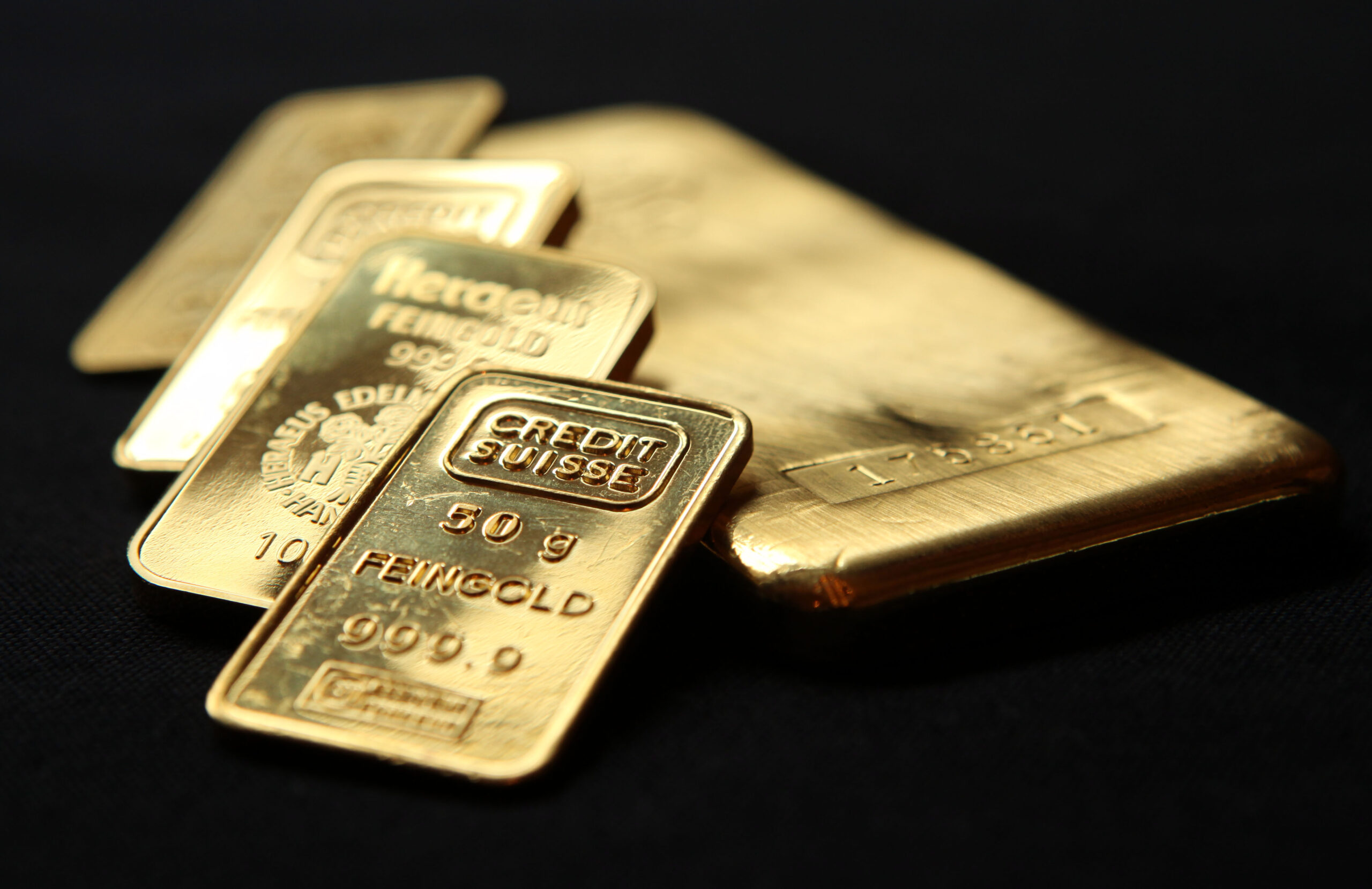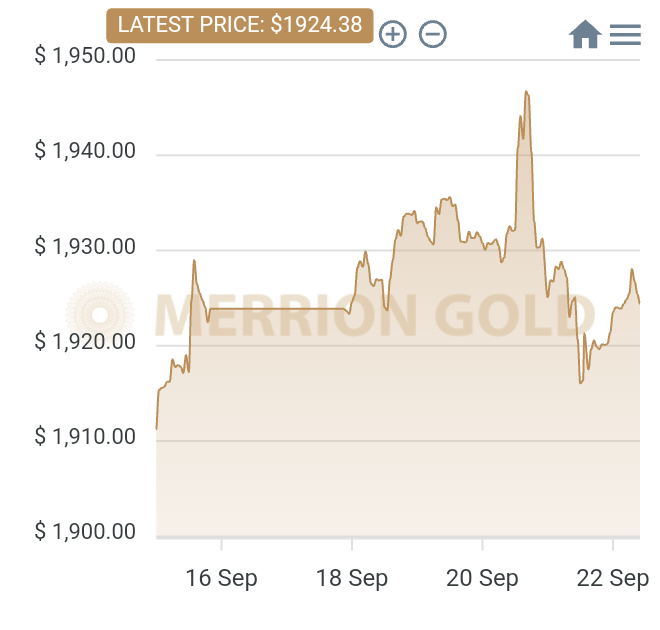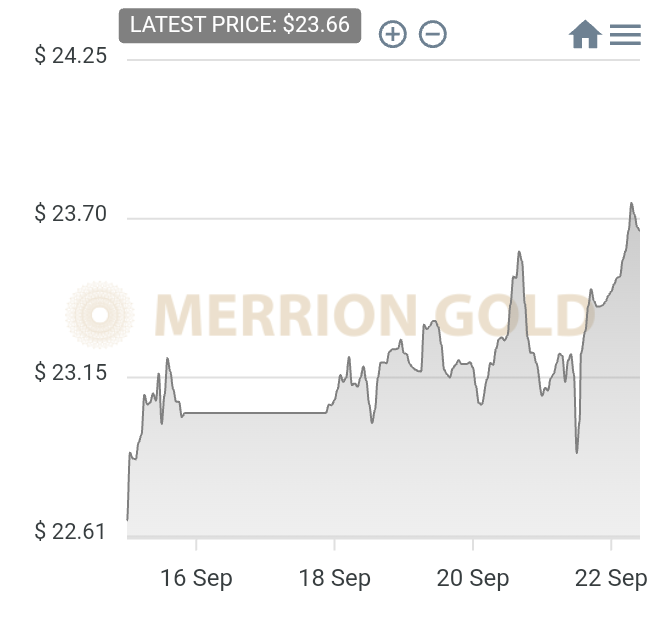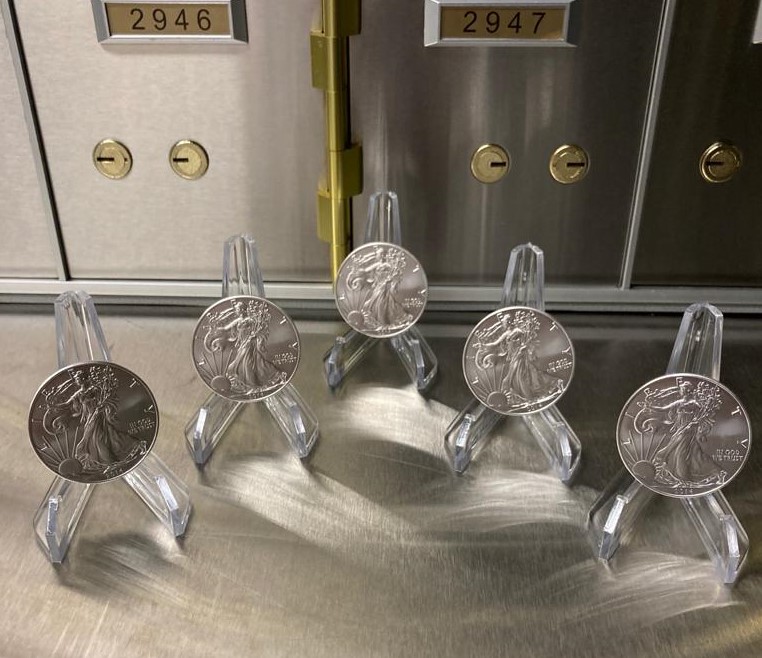
22/09/2023: This Week in Gold with Market Updates:
Price Action:
Gold:
Gold opened the week trading at $1,925 and followed a slight upward trajectory for much of the trading day. Price was pushed up on the back of a dip in the dollar which was influenced by anticipation of multiple Central Bank policy meetings occurring throughout the week. Gold finished the day 0.47% higher at $1,934.
Tuesday saw gold consolidate for the full trading day, ultimately finishing the day $1 lower at $1,932. ECB CPI was released during the day, with data for headline and core inflation coming in either as forecasted or lower.
On Wednesday, gold prices surged as much as 0.72% to the upside to reach a weekly high of $1,947. However, the gains experienced during the trading day were reversed by the close. Although the FED decided to pause rates, a hawkish stance on future policy remains. This was reiterated in FED Chair Powells’ statement. Gold fell from the weekly high to close the trading day slightly lower than what it opened at i.e. $1,932 to $1,931. The fall was also pushed on by the dollar’s gain and the jump in benchmark 10-year yields.
Gold extended the losing streak it had been to three consecutive days on Thursday, as price fell due to surges in the dollar and in bond yields. The FED reiterated the hawkish stance it has on future policy, with the expectation being that rates will be higher for longer. Gold fell a further 0.5% to $1,921. BMK 10-year Treasuries hit the highest point in 16 years. The inverse relationship that gold has with yields means that as yields move higher, gold falls.
Pound-denominated gold began to rise toward the close of trading on Thursday. This was largely in response to the BOE interest rate decision earlier on in the day. The BOE decided to pause rates which provided investors with hope that the peak in rates has been reached. Potential for lower rates led to a fall in the pound which in turn began to push gold higher.
At the time of writing, gold is trading at $1,924 meaning it is currently $1 or 0.05% lower for the week.
Below is a graph highlighting gold’s price movements throughout the week:

Silver:
Silver opened the week trading at $23.08. Like gold, price started the week with a slight advance in price to the upside in anticipation of a FED pause. Similarly to gold, silver is affected by moves in the dollar, and a weaker dollar on Monday pushed silver higher. Silver closed the day at $23.29.
On Tuesday, silver retraced slightly, closing the day just $0.07 lower than the open at $23.21. As the dollar pared losses from the previous day, the metal did not advance throughout the day.
With the FED’s interest rate decision being released on Wednesday, silver advanced in anticipation, moving as much as 1.6% to the upside. As mentioned, the FED’s hawkish stance on future policy led to the reversal of the gains that were experienced earlier on in the day.
On Thursday, silver fell below $23 for the first time during the week, hitting a weekly low of $22.90. Silver quickly bounced off of that level and began to steadily increase throughout the day. Price advanced to close the day 1% higher at $23.44.
Silver continued the advances experienced at the close on Thursday and hit a weekly high of $23.76 on Friday.
At the time of writing, silver trades at $23.65 which is slightly lower than the weekly high that was experienced after markets opened for trading.
Below is a graph highlighting silver’s price movements throughout the week:

Market Updates:
ECB CPI:
The European Central Bank released CPI data on Tuesday, with data for both headline and core coming in either as expected or lower than expected.
Headline inflation came in cooler year-on-year at 5.2%, down from the previous month’s figure of 5.3%. Month-on-month, CPI was 0.5%, also down 0.1% from the previous month’s figure of 0.6%. Although inflation remains high, it is a welcome sign to the ECB that the Central Bank’s tightening policies seem to be cooling inflation levels.
Core CPI, which excludes volatile food and energy prices, remained unchanged for both year-on-year and month-on-month at 5.3% and 0.3%, respectively.
The ECB’s primary goal is to lower inflation levels to the target range of 2%.
U.K. CPI:
The U.K. released CPI data on Wednesday, and headline and core CPI cooled from the previous month. Year-on-Year, headline inflation cooled to 6.7%, down from 7%. Core CPI cooled to 6.2% from 6.8%. Month-on-Month also experienced a decline, with headline inflation falling to 0.3% from 0.7%, and Core CPI falling to 0.1% from 0.6%.
The U.K.’s latest CPI release shows that inflation remains high but the decline shows that the Bank of England’s QT policies are beginning to cool rising prices.
FED Interest Rates:
The FED’s decision on the future of interest rates also occurred on Wednesday. The FED decided to leave rates unchanged, meaning that the hiking cycle would be paused for now. However, FED Chair Powell stated that rates could potentially stay higher for longer.
Investors had anticipated the latest pause, with the decision already being priced into markets prior to the meeting. It was Powell’s comments after the decision that began to stir markets, with the FED’s hawkish stance on future policy decisions leading to a sell-off in equity and gold markets, while pushing the dollar and U.S. Treasury yields higher.
As gold has an inverse relationship with bond yields, the rise in Benchmark Treasuries to 16-year highs led to a fall in the price of gold. Generally, investors move out of assets that do offer a fixed-income when yields for fixed-income assets remain high, or move higher.
U.K. Interest Rates:
The Bank of England, like the FED the day previous, decided to leave rates unchanged. This pause was a welcome sign for U.K. investors. This gave hope to the fact that there may not be any further rate hikes.
The BOE mentioned in a statement after the rate decision, that it would not be taking the most recent inflation data for granted.
This would be the case for all Central Banks, as the FED, ECB, and BOE remain determined on tackling inflation and bringing it back to the target range of 2%. This means that investors should not rule out future rate hikes.
Conclusion:
With a lot of economic data being released throughout the week, the primary event that affected the price of gold in dollar terms was the FED’s comments after the decision to keep rates unchanged. Many investors were hoping that the FED’s pause would be the beginning of a potential rate cut cycle. However, the FED’s hawkish stance on future policy decisions, pushed the dollar and bond yields higher, which then pushed gold lower.
Thank you for taking the time to read Merrion Gold’s weekly review on the markets, and if you would like to find out more on investment in gold and silver, please contact our trading team directly by phone: 01 254 7901 or by email: info@merriongold.ie.

